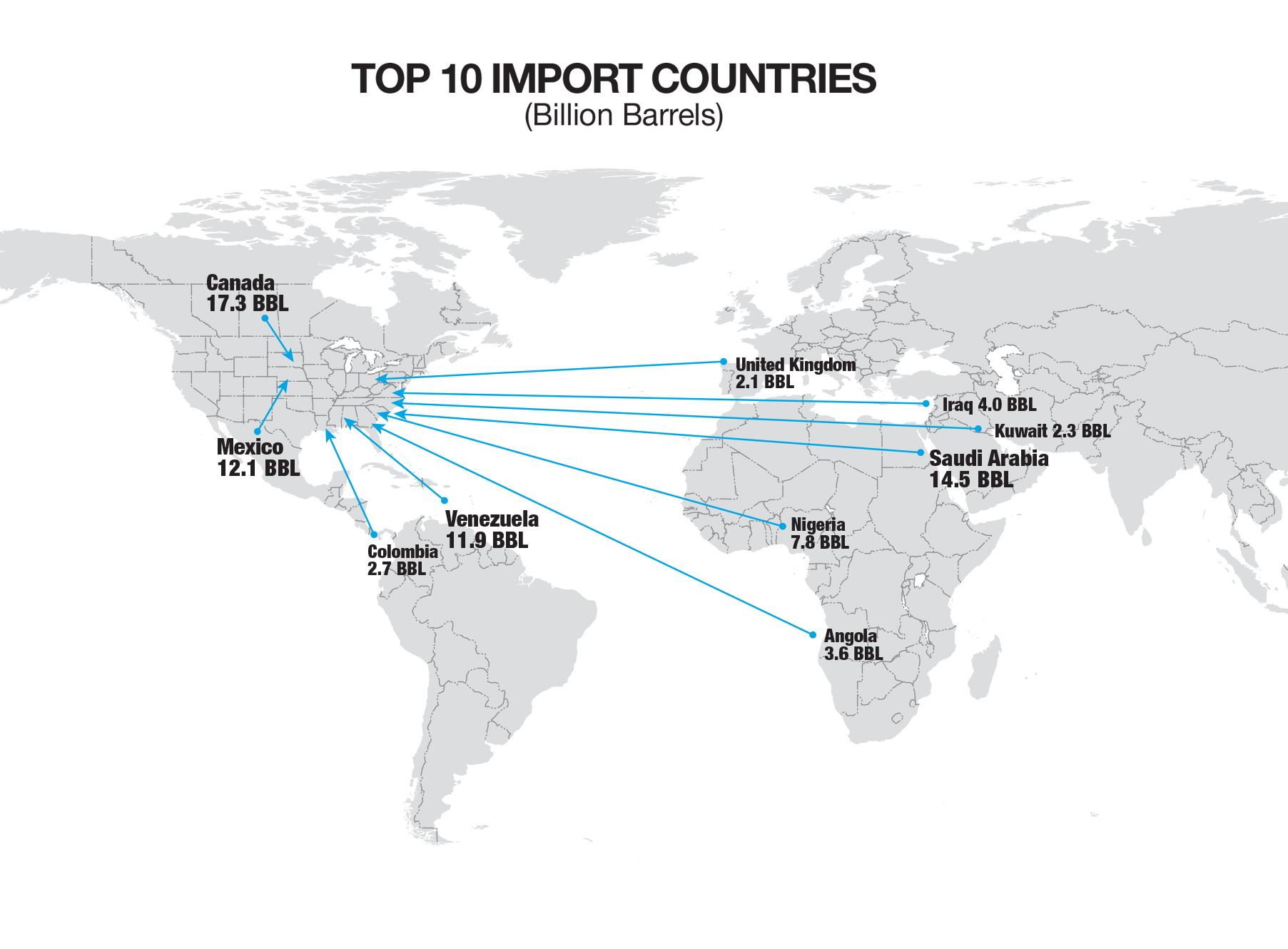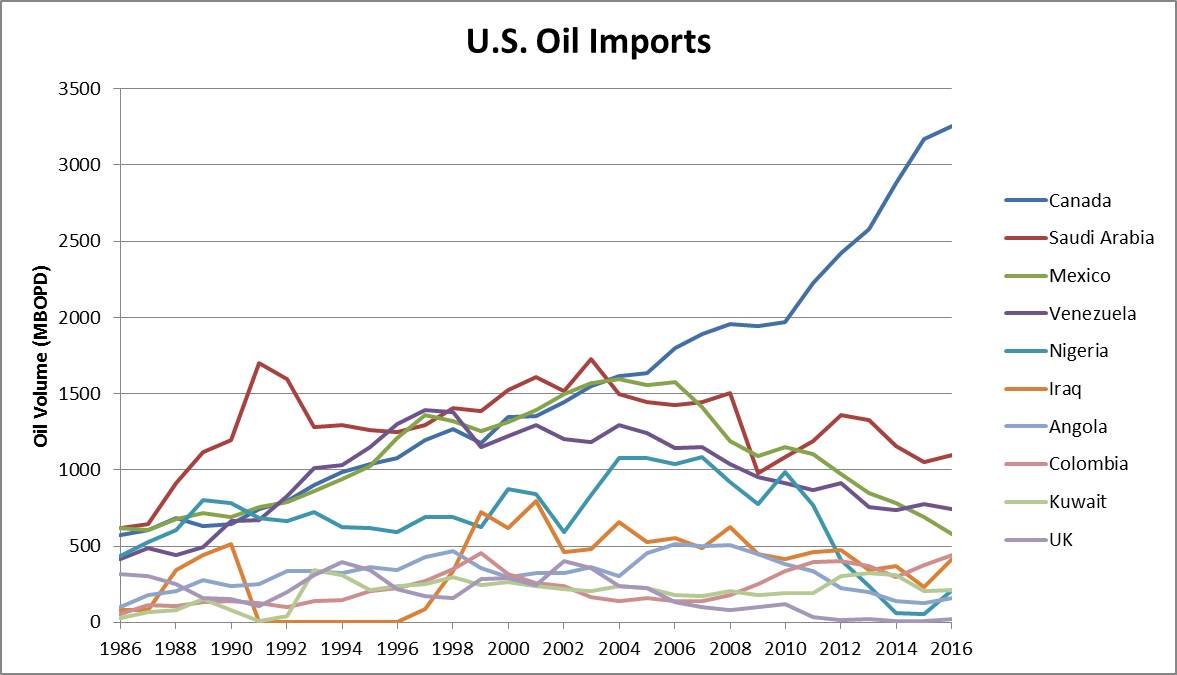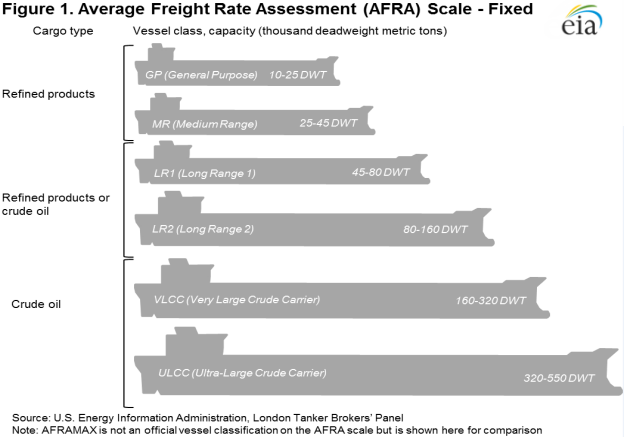U.S. has brought into its refineries crude oil from 80 nations
In the past 30 years the U.S. has imported more than 91 billion barrels of oil, drawing from a large variety of sources.
The EIA began carefully tracking American oil imports in 1986, meaning there is now now a significant amount of historical data. From 1986 to 2016 the U.S. imported 91.2 billion barrels of crude oil, in just under 244,000 individual records.
In total, the EIA lists 80 different countries from which the U.S. has imported crude oil.
The top ten countries are listed below by oil volume. These ten represent 86% of all imports in the last thirty years.
| Rank | Country | Oil Volume (billion barrels) |
| 1 | CANADA | 17.288 |
| 2 | SAUDI ARABIA | 14.528 |
| 3 | MEXICO | 12.093 |
| 4 | VENEZUELA | 11.885 |
| 5 | NIGERIA | 7.773 |
| 6 | IRAQ | 4.018 |
| 7 | ANGOLA | 3.610 |
| 8 | COLOMBIA | 2.658 |
| 9 | KUWAIT | 2.255 |
| 10 | UNITED KINGDOM | 2.141 |
U.S. has bought 17.3 billion barrels from Canada
Canada has provided the most oil to the U.S.—a total of 17.3 billion barrels since 1986. Imports from Canada have been growing steadily, powered primarily by oil sand production. The country has been main source of imported oil for the U.S. since 2004, and has grown significantly since then. The U.S. imported more than 3,250 MBOPD from Canada last year, nearly triple the volume imported from Saudi Arabia.
Saudi Arabia is No. 2 U.S. oil provider at 14.5 billion barrels
Saudi Arabia has sent the U.S. more than 14.5 billion barrels of oil since 1986. It’s the U.S.’s second-largest oil source. Imports from the OPEC leader are falling however, gradually declining from the peak 1,726 MBOPD America received in 2003. In 2016, the U.S. imported 1,097 MBOPD from the kingdom, making it our current second-largest oil source.
Mexico is No. 3 at 12.1 billion barrels
Perhaps more surprising is third place: Mexico. At 12.1 billion total barrels, Mexico was actually the primary import partner of the U.S. back in 1986, and has always been in the top five sources. Production from the country has been declining in recent years however, and lower supply combined with growth in U.S. shale production mean Mexican oil exports to the U.S. have been decreasing. Current export rates are down nearly two thirds from their peak in 2004.
Venezuela has sold the U.S. 11.9 billion barrels, fourth largest source of crude oil
Despite occasionally rocky relationships with the U.S., Venezuela has been America’s fourth-largest source of oil since 1986. The heavy oil producer has provided the U.S. with about 11.9 billion barrels of oil over the last thirty years. In 1996 and 1997 Venezuela ranked first among America’s oil import partners. Like Mexico, however, imports from Venezuela are currently declining. Venezuela’s current economic troubles and unrest will likely push imports down further.
Shale production forces out Nigerian oil, the U.S.’s fifth largest crude source at 7.8 billion barrels
Rounding out the top five is Nigeria, which was once the second-largest provider of oil to the U.S. The African nation has sent the U.S. about 7.8 billion barrels of oil in the last three decades. Imports from Nigeria are typically lighter crude, similar in grade to the oil produced in U.S. shale operations. The shale boom quickly forced Nigeria out of the U.S. market, as unconventional crude flooded the market. In 2010 the U.S. imported 983 MBOPD of oil from Nigeria. Only four years later, though, this value had fallen to merely 58 MBOPD, a drop of 94%. This situation is not likely to change any time soon, as U.S. shale is projected to grow significantly in 2017.
North Sea production in decline
Iraq, Angola, Colombia Kuwait and the UK represent the 6th through 10th largest sources of oil for the U.S. Of these, the UK has seen the largest change in production. Imports from the North Sea, or the UK and Norway combined, were once a major source of oil for the U.S. In 2002 the two countries exported 753 MBOPD of oil to the U.S. Like many other oil trade partners of the U.S., however, declining production has sharply decreased imports. In 2014 the U.S. imported only 19 MBOPD from the UK and Norway, representing a decline of 97%.
Several unexpected nations
The list of sources of oil for the U.S. also includes several countries that might be surprising.
Trinidad and Tobago ranks relatively high in volume delivered to the U.S. due to a quirk in regulations. Many American ports are too small to accommodate the largest supertankers that are most economic to transfer oil over long distances. To get around this, it is common to offload large tankers onto smaller ships, which then take the oil to the port. In such situations, the country in which the large tanker is flagged is often recorded as the source of the oil.
Trinidad and Tobago is a popular country to register vessels, inflating its ranking as an oil trade partner.
Sweden is another unexpected import partner, but the Scandinavian nation has sent the U.S. 266,000 barrels of oil. Kyrgyzstan, a landlocked nation in the heart of Asia, has provided the U.S. with 601,000 barrels of oil despite being more than 1,000 miles from any ocean.
Ra’s Al Khaymah and Ajman are two sources of oil on the DOE import roster. Both are individual emirates in the UAE.
Perhaps the most odd source of oil is listed as “Neutral Zone.” This most likely refers to the Saudi-Kuwaiti neutral zone, the southern section of Kuwait . The U.S. received 3.3 million barrels from this area in early 1988.
This article is second in a series looking at the volume and nature of oil imported by the U.S. and the impact of U.S. shale on the dynamics of the industry. In follow-up stories we will examine imports from OPEC members specifically.—Oil & Gas 360®




